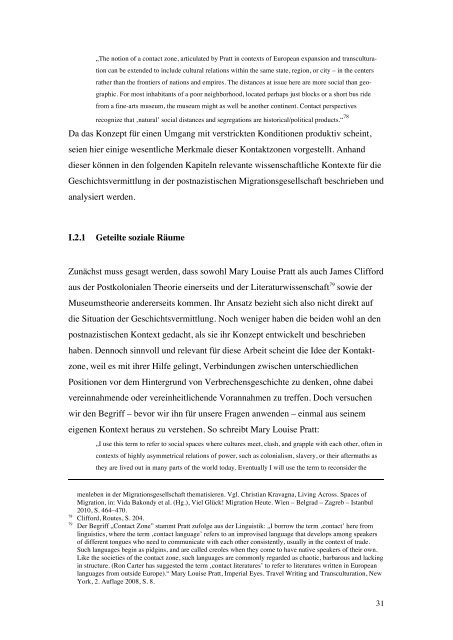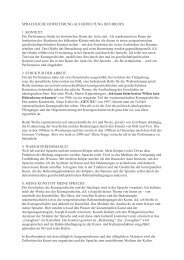Kontaktzonen der Geschichtsvermittlung Transnationales Lernen
Kontaktzonen der Geschichtsvermittlung Transnationales Lernen
Kontaktzonen der Geschichtsvermittlung Transnationales Lernen
Erfolgreiche ePaper selbst erstellen
Machen Sie aus Ihren PDF Publikationen ein blätterbares Flipbook mit unserer einzigartigen Google optimierten e-Paper Software.
„The notion of a contact zone, articulated by Pratt in contexts of European expansion and transculturation<br />
can be extended to include cultural relations within the same state, region, or city – in the centers<br />
rather than the frontiers of nations and empires. The distances at issue here are more social than geographic.<br />
For most inhabitants of a poor neighborhood, located perhaps just blocks or a short bus ride<br />
from a fine-arts museum, the museum might as well be another continent. Contact perspectives<br />
recognize that ‚natural’ social distances and segregations are historical/political products.“ 78<br />
Da das Konzept für einen Umgang mit verstrickten Konditionen produktiv scheint,<br />
seien hier einige wesentliche Merkmale dieser <strong>Kontaktzonen</strong> vorgestellt. Anhand<br />
dieser können in den folgenden Kapiteln relevante wissenschaftliche Kontexte für die<br />
<strong>Geschichtsvermittlung</strong> in <strong>der</strong> postnazistischen Migrationsgesellschaft beschrieben und<br />
analysiert werden.<br />
I.2.1<br />
Geteilte soziale Räume<br />
Zunächst muss gesagt werden, dass sowohl Mary Louise Pratt als auch James Clifford<br />
aus <strong>der</strong> Postkolonialen Theorie einerseits und <strong>der</strong> Literaturwissenschaft 79 sowie <strong>der</strong><br />
Museumstheorie an<strong>der</strong>erseits kommen. Ihr Ansatz bezieht sich also nicht direkt auf<br />
die Situation <strong>der</strong> <strong>Geschichtsvermittlung</strong>. Noch weniger haben die beiden wohl an den<br />
postnazistischen Kontext gedacht, als sie ihr Konzept entwickelt und beschrieben<br />
haben. Dennoch sinnvoll und relevant für diese Arbeit scheint die Idee <strong>der</strong> Kontaktzone,<br />
weil es mit ihrer Hilfe gelingt, Verbindungen zwischen unterschiedlichen<br />
Positionen vor dem Hintergrund von Verbrechensgeschichte zu denken, ohne dabei<br />
vereinnahmende o<strong>der</strong> vereinheitlichende Vorannahmen zu treffen. Doch versuchen<br />
wir den Begriff – bevor wir ihn für unsere Fragen anwenden – einmal aus seinem<br />
eigenen Kontext heraus zu verstehen. So schreibt Mary Louise Pratt:<br />
„I use this term to refer to social spaces where cultures meet, clash, and grapple with each other, often in<br />
contexts of highly asymmetrical relations of power, such as colonialism, slavery, or their aftermaths as<br />
they are lived out in many parts of the world today. Eventually I will use the term to reconsi<strong>der</strong> the<br />
78<br />
79<br />
menleben in <strong>der</strong> Migrationsgesellschaft thematisieren. Vgl. Christian Kravagna, Living Across. Spaces of<br />
Migration, in: Vida Bakondy et al. (Hg.), Viel Glück! Migration Heute. Wien – Belgrad – Zagreb – Istanbul<br />
2010, S. 464–470.<br />
Clifford, Routes, S. 204.<br />
Der Begriff „Contact Zone” stammt Pratt zufolge aus <strong>der</strong> Linguistik: „I borrow the term ‚contact’ here from<br />
linguistics, where the term ‚contact language’ refers to an improvised language that develops among speakers<br />
of different tongues who need to communicate with each other consistently, usually in the context of trade.<br />
Such languages begin as pidgins, and are called creoles when they come to have native speakers of their own.<br />
Like the societies of the contact zone, such languages are commonly regarded as chaotic, barbarous and lacking<br />
in structure. (Ron Carter has suggested the term ‚contact literatures’ to refer to literatures written in European<br />
languages from outside Europe).“ Mary Louise Pratt, Imperial Eyes. Travel Writing and Transculturation, New<br />
York, 2. Auflage 2008, S. 8.<br />
31



